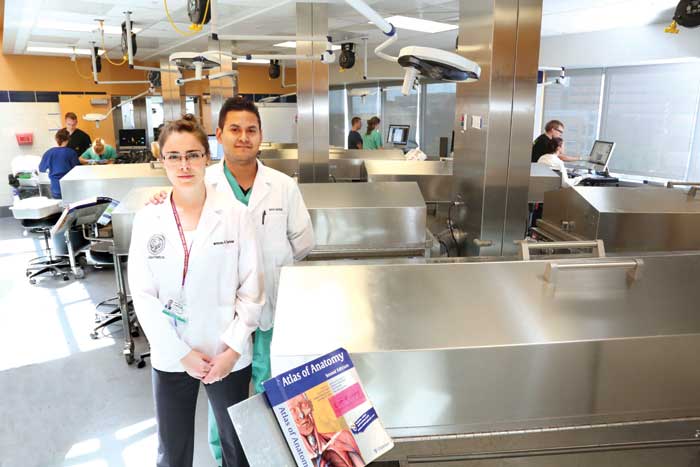
Whitney Sumner and Jason Santiago stand in the lab at the University of Colorado School of Medicine where they worked on cadavers as part of their semester-long anatomy class.
Whitney Sumner distinctly remembers the initial shock of looking at the dead body for the first time. Until now she hadn’t really considered what it meant to spend four hours a day, five days a week with a dead body.
The donor had died at 94 of general failure, the only information Sumner and the three other students in her lab group had received.
Students in human anatomy courses at the University of Colorado School of Medicine at the Anschutz Campus spend a semester working on cadavers. Students begin the course with a range of emotions—some uncomfortable, others invasive, a few too distraught to stay in the course. But eventually, quicker for some than others, excitement about the opportunity outweighs uneasiness.
According to the State Anatomical Board, body donation provides an indispensable learning tool for students. They learn the complexity and intricacy of the human body by dissecting every major nerve and muscle, including the brain.
“There’s absolutely no substitute for working on a cadaver,” says Sumner, vice president of the class of 2017. She is grateful for the gift from the 94-year-old woman her group nicknamed Lucy.
Some days students worked so hard they forgot it’s a human body; other days they were overwhelmingly aware they were real people.
Discovering anatomical differences among the cadavers made the students wonder more about them as people: Is the roughness of his hand because he had a blue-collar job? How did she get this scar? Does Lucy’s family know she’s missing her second toes? For Sumner, she had begun to feel connected to Lucy despite knowing nothing about her. Dissecting the hands was the most difficult. “I held her hand like I would hold a friend’s who I was walking with. I didn’t even notice that I was doing that,” she says.
“It’s this full-circle experience because you want to make the patient better, but obviously it culminates in this life cycle reality of death,” she says. “I think it’s important to have that gravity to be a medical professional.” Sumner wants to go into radiation oncology, where she knows she will often deliver tough news to patients and their families. Like many students in the anatomy course, she considers Lucy her first patient.
“On some level you almost feel guilty thinking that you know the person because why should I think I had anything to do with this person’s life? That’s not really something that I’m even allowed to feel.”
At times, Sumner was thankful she didn’t have much information about Lucy, and other times she desperately wanted to know what she was like, although admitting it would make the experience more emotional. But most of all she wishes she could know why Lucy became a donor.
People become whole body donors for a variety of reasons.
Mary Oba’s husband, Calvin, was a donor this past year. She says it was his way of continuing his dedication to medicine. “He told me he was married to his profession, and I would always be second. I didn’t believe that, but of course it was true,” she says and laughs.
Cal, a first-generation Japanese American, graduated from the Colorado School of Medicine in 1957. His commitment to delivering exceptional care surpassed most. He received multiple humanitarian awards throughout his career as first a general practitioner and then orthopedic surgeon. He once delivered a baby in the back of his car. Another time he saved a man’s life by clamping a blood vessel with his hemostat to stop the bleeding. His children always said he is the kind of man you would want to be your doctor.
But with his work ethic came intense expectations. He loved his family, but demanded perfection. “He was a bit obsessive,” Mary says. Whenever he had an idle moment, he was either asleep—he could sleep anywhere, including over his microscope—or searching for something tedious to do. After he died, Mary found rows of jars in the garage filled with rusty nails organized by size.
She wasn’t surprised he decided to be a whole body donor, which she has also decided to do. “The opportunity to be of service to new students coming in was perfect for Cal. He wanted to do what he could until the very last.”
Jason Santiago, class of 2017 and a Stapleton resident, says it takes a special person to become a body donor. “It’s very revealing. Most people aren’t comfortable with that sort of idea.”
To honor body donors, students host a ceremony at the end of the semester for family members. Students give speeches about their experience throughout the semester, giving closure to some families who had not grieved yet, including Mary who cried on a doctor’s shoulder after the ceremony, which she laughs might have been “nutty but necessary.”
“It’s a hard situation,” Santiago says. “Some of us students were apprehensive, but it was really well received.” On the last day of lab, he and his group had a moment of silence for their donor and “member of the team.”



0 Comments